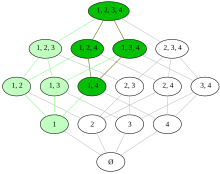This article may be too long to read and navigate comfortably. (November 2022) |

Filters in topology, a subfield of mathematics, can be used to study topological spaces and define all basic topological notions such as convergence, continuity, compactness, and more. Filters, which are special families of subsets of some given set, also provide a common framework for defining various types of limits of functions such as limits from the left/right, to infinity, to a point or a set, and many others. Special types of filters called ultrafilters have many useful technical properties and they may often be used in place of arbitrary filters.
Filters have generalizations called prefilters (also known as filter bases) and filter subbases, all of which appear naturally and repeatedly throughout topology. Examples include neighborhood filters/bases/subbases and uniformities. Every filter is a prefilter and both are filter subbases. Every prefilter and filter subbase is contained in a unique smallest filter, which they are said to generate. This establishes a relationship between filters and prefilters that may often be exploited to allow one to use whichever of these two notions is more technically convenient. There is a certain preorder on families of sets, denoted by that helps to determine exactly when and how one notion (filter, prefilter, etc.) can or cannot be used in place of another. This preorder's importance is amplified by the fact that it also defines the notion of filter convergence, where by definition, a filter (or prefilter) converges to a point if and only if where is that point's neighborhood filter. Consequently, subordination also plays an important role in many concepts that are related to convergence, such as cluster points and limits of functions. In addition, the relation which denotes and is expressed by saying that is subordinate to also establishes a relationship in which is to as a subsequence is to a sequence (that is, the relation which is called subordination, is for filters the analog of "is a subsequence of").
Filters were introduced by Henri Cartan in 1937[1] and subsequently used by Bourbaki in their book Topologie Générale as an alternative to the similar notion of a net developed in 1922 by E. H. Moore and H. L. Smith. Filters can also be used to characterize the notions of sequence and net convergence. But unlike[note 1] sequence and net convergence, filter convergence is defined entirely in terms of subsets of the topological space and so it provides a notion of convergence that is completely intrinsic to the topological space; indeed, the category of topological spaces can be equivalently defined entirely in terms of filters. Every net induces a canonical filter and dually, every filter induces a canonical net, where this induced net (resp. induced filter) converges to a point if and only if the same is true of the original filter (resp. net). This characterization also holds for many other definitions such as cluster points. These relationships make it possible to switch between filters and nets, and they often also allow one to choose whichever of these two notions (filter or net) is more convenient for the problem at hand. However, assuming that "subnet" is defined using either of its most popular definitions (which are those given by Willard and by Kelley), then in general, this relationship does not extend to subordinate filters and subnets because as detailed below, there exist subordinate filters whose filter/subordinate–filter relationship cannot be described in terms of the corresponding net/subnet relationship; this issue can however be resolved by using a less commonly encountered definition of "subnet", which is that of an AA–subnet.
Thus filters/prefilters and this single preorder provide a framework that seamlessly ties together fundamental topological concepts such as topological spaces (via neighborhood filters), neighborhood bases, convergence, various limits of functions, continuity, compactness, sequences (via sequential filters), the filter equivalent of "subsequence" (subordination), uniform spaces, and more; concepts that otherwise seem relatively disparate and whose relationships are less clear.
Cite error: There are <ref group=note> tags on this page, but the references will not show without a {{reflist|group=note}} template (see the help page).














